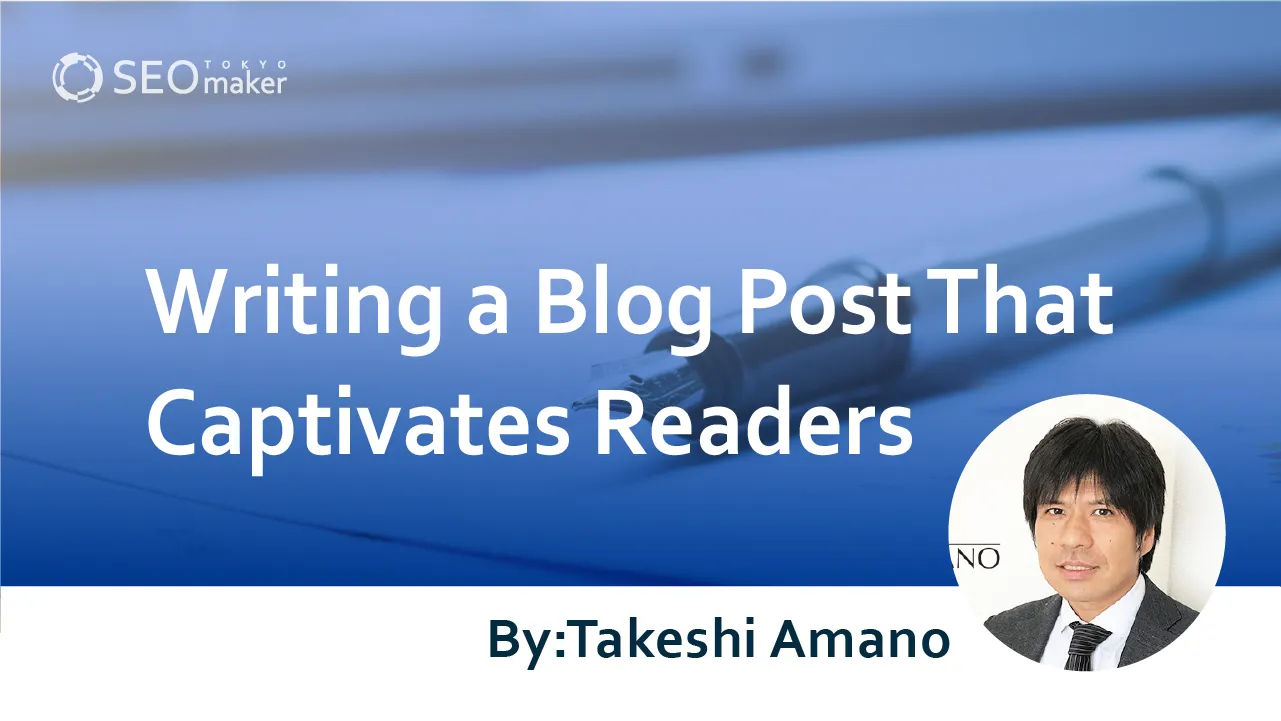Writing a Blog Post That Captivates Readers : A Beginner’s Guide
contents
- 1 What You Need to Do Before Writing a Blog
- 2 Things to Consider Before Writing a Blog
- 3 Top 10 Tips for Writing a Blog
- 3.1 Include Keywords in the Article Title
- 3.2 Start with the Conclusion or Main Points
- 3.3 Use Paragraph Breaks to Enhance Readability
- 3.4 Include Diagrams or Images
- 3.5 Use Bullet Points
- 3.6 Pay Attention to the Use of Hiragana, Katakana, and Kanji
- 3.7 Reduce the Use of Demonstrative Pronouns
- 3.8 Include a Clear Summary
- 3.9 Check for Typos and Misspellings
- 3.10 Reduce the Use of Conjunctions, Pronouns, and Modifiers
- 4 Summary
 When writing a blog, it’s crucial to create your articles from the reader’s perspective. Think about what your readers need from your blog (content) and if you can grasp their needs, you’ll be able to produce quality content. Naturally, high-quality content also enhances SEO effectiveness.
When writing a blog, it’s crucial to create your articles from the reader’s perspective. Think about what your readers need from your blog (content) and if you can grasp their needs, you’ll be able to produce quality content. Naturally, high-quality content also enhances SEO effectiveness.
A shortcut to attracting users is to learn the know-how of blog writing and to produce high-quality content.
In this session, we will explain the essential tips and techniques for writing blog articles.
What You Need to Do Before Writing a Blog
Before you start writing a blog, it’s important to carefully plan the structure of your article content and decide on the theme.
Once the structure and theme are set, you move on to researching the content to write. Defining your target audience will give you a clear direction.
To determine your target, you need to develop a persona. From this persona, you set your target audience and prepare to write your blog.
Recommended article: What is a Persona? Why It’s Necessary in Marketing and How to Define One
Things to Consider Before Writing a Blog
Here are some points to keep in mind to create good content.
- Define your target audience from the persona
- Write logical and clear text (using the PREP method)
- Plan your theme and article structure in advance
- Select keywords
- Conduct competitor analysis
- Explore search intent
Defining Your Target Audience from the Persona
To write a blog post that captivates readers, you first need to know your readers, represented by the persona. You hypothesize and define your target audience by detailing attributes like name, age, gender, occupation, income, residence, hobbies, values, and lifestyle as if they were real people.
While a persona is a fictitious individual, the target refers to an actual group. For example, the target might be ‘men in their 40s working in web marketing.’
Once the target is established, you can tailor the tone of your writing and refine your communication to resonate with and captivate your readers.
Writing Logical and Understandable Blog Posts
When writing a blog article, constructing a logical flow helps convey your message clearly to the reader.
For building a logical structure, the “PREP method” is highly recommended.
The PREP method stands for “Point, Reason, Example, Point.” This structure starts with your conclusion, followed by the reasons, then examples, and concludes with the point again.
Following this order can help you maintain a logical flow in your article, which is especially useful for those new to blog writing.
Planning Your Theme and Article Structure in Advance
It’s beneficial to focus on one theme per blog post. Concentrating on a single theme can enhance your SEO as it’s more likely to be recognized by search algorithms and prevents readers from getting confused.
Choose a blog theme related to keywords with a significant number of monthly searches. This approach can increase your chances of ranking higher in SEO results and driving traffic to your site.
Once you’ve decided on the theme and target audience, you can proceed to outline the article structure. Having a structure in place helps you understand the entire article and identify the necessary elements.
An article’s structure should be planned from the main headers (H2) down to sub-headers (H3, H4), including the lead paragraph, the main body, and the conclusion. Finalizing the structure, writing each section, and then deciding on the title is a good strategy.
Selecting Keywords
When writing a blog post, consider what search terms (queries) users might use to find your article. If you’re writing just for the sake of it, keyword selection may not be necessary. However, if you want others to read your blog, choosing the right keywords for your target audience is crucial.
You can use tools like Google AdWords’ Keyword Planner to find keywords. Keywords with high monthly search volumes are highly competitive and harder to rank for.
Keywords with lower search volumes have fewer competitors, offering a better chance to rank high, but they also attract fewer visitors due to the lower search volume. Assess the strength of your blog site and choose between targeting middle-range keywords or long-tail keywords based on your strategy.
Recommended article: What is Search Volume? A Comprehensive Guide to Understanding and Researching Keyword Volume
Conducting Competitor Analysis
Before you start writing your blog, it’s essential to conduct a competitor analysis. Once you have decided on your keywords, research the top-ranking sites for these keywords to see how long their blog posts are and what type of content they include. At a minimum, study the top 10 sites ranked from first to tenth.
The content elements used by these competitors are likely crucial for ranking highly with those keywords, and it’s important to incorporate these elements into your own blog as well.
By analyzing the competition, you can understand the scale of the blog page you need before you start creating your own.
Exploring Search Intent
Search intent refers to the purpose behind a user’s search query. Understanding search intent reveals what readers are looking for. Knowing their needs helps you determine the necessary elements for your content.
Uncovering both explicit and latent needs through research of search intent, and incorporating these into your articles can enhance the quality of your content and improve its ranking.
Explicit needs are those the reader is aware of, while latent needs are those the reader may not yet recognize.
You can address explicit needs with elements identified from competitor analysis. Addressing latent needs often requires original content that competitors may not yet have explored, necessitating brainstorming and planning.
Top 10 Tips for Writing a Blog
Here are ten tips for writing a blog that I’d like to share.
- Include keywords in the article title.
- Start with the conclusion or main points.
- Use paragraph breaks to enhance readability.
- Include diagrams or images.
- Use bullet points.
- Pay attention to the use of Hiragana, Katakana, and Kanji.
- Reduce the use of demonstrative pronouns.
- Include a clear summary.
- Check for typos and misspellings.
- Reduce the use of conjunctions, pronouns, and modifiers.
Include Keywords in the Article Title
As previously mentioned, selecting the right keywords is crucial. For better SEO performance, place keywords at the beginning of your article title. The title of your site page is the most influential SEO factor, so try to make it sound natural while incorporating the necessary keywords.
The article title should be placed within the head tag’s title element.
Recommended article: What is the Effective Length of an SEO Title? Explaining How to Set Titles and Title Tags
Start with the Conclusion or Main Points
In the structure of your article, insert the lead paragraph right after the title. By stating the conclusion or main points early, you increase user satisfaction. Search users are looking for answers based on their search intent, so it’s important to convey the key points or conclusion at the beginning. If the lead paragraph indicates that the desired information might be forthcoming, it can prevent user drop-off and save readers’ time.
Use Paragraph Breaks to Enhance Readability
When your blog post becomes lengthy, always use paragraph breaks to improve readability. Adding breaks makes the content easier to read, which improves usability and has a positive impact on SEO.
Include Diagrams or Images
Images and diagrams greatly assist readers in understanding the text. Incorporating these elements adds visual appeal and enhances the persuasiveness of your content. Using images or diagrams can also reduce reader drop-off and improve usability, boosting your SEO ranking.
Use Bullet Points
When writing, using bullet points can help organize information, making it easier for readers to understand. If you have three or more points or elements, presenting them in bullet points first can make your content clearer and more effective.
Pay Attention to the Use of Hiragana, Katakana, and Kanji
For readability, it’s beneficial to skillfully differentiate between Hiragana, Katakana, and Kanji when writing. The recommended balance is often said to be 70% Hiragana, 20% Kanji, and 10% Katakana. Avoid using more than five consecutive Kanji characters to maintain a good balance.
Reduce the Use of Demonstrative Pronouns
The term “kosoado” refers to demonstrative pronouns, such as “this,” “that,” “which,” etc. Reducing the use of these words in your articles can decrease the chances of mistakes.
Demonstrative pronouns can make the text difficult to read if not used correctly due to the differences in distance and part of speech they represent. It’s important to choose and use the appropriate demonstrative pronoun accurately.
Include a Clear Summary
Always end your blog articles with a summary paragraph. Start with the conclusion in the lead paragraph, use the subheadings to provide examples and strengthen the credibility of the conclusion, and finally summarize the main points and message you wanted to convey.
The summary helps the reader to reacknowledge the important aspects and effectively concludes the article.
Check for Typos and Misspellings
After completing your writing, set aside time to check for typos and misspellings. Typos can undermine the overall credibility and quality of your article. Conversion errors are common, leading to unnoticed typos. Rechecking your work on a different day can make it easier to spot any mistakes.
Reduce the Use of Conjunctions, Pronouns, and Modifiers
It’s advisable to minimize the use of conjunctions and pronouns. Overusing conjunctions can make the writing seem verbose. Eliminating unnecessary pronouns can make the text clearer and more direct. Repeating the same modifiers can also make the text cluttered; removing redundant modifiers can enhance readability.
Summary
To captivate your audience with an SEO consultant blog post, prioritizing the quality of your content is crucial. Before you start writing, determine your target audience and the theme, and carefully plan the structure. Aim to begin your writing with clear, concise conclusions. Writing original blog posts with a high degree of uniqueness, while incorporating nuanced SEO techniques, can capture readers’ hearts and achieve high SEO rankings. Always consider the reader’s perspective to truly engage your audience.










![What is a Description? Explaining the Meaning, Writing Style, and Changing Word Count – [2023 Edition]](https://www.switchitmaker2.com/en/wp-content/uploads/2024/09/what-is-description.webp)










